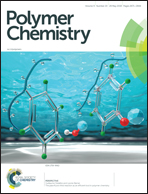(PtBA-co-PPEGMEMA-co-PDOMA)-g-PPFA polymer brushes synthesized by sequential RAFT polymerization and ATRP†
Abstract
A novel approach for preparing self-cleaning anti-fouling surfaces with compositional heterogeneous polymer brushes at a molecular-length scale was developed. This approach exploits three critical elements including hydrophilic poly(ethylene glycol) (PEG) brushes with non-fouling functionalities, self-cleaning fouling-release hydrophobic poly(2,2,3,3,3-pentafluoropropyl acrylate) (PPFA) brushes and catechol moieties, an important component of mussel adhesive proteins (MAPs), to anchor asymmetric polymer brushes onto surfaces. Well-defined PtBBPMA-co-PPEGMEMA-co-PDOMA macroinitiators were first prepared by RAFT copolymerization of tert-butyl 2-((2-bromopropanoyloxy)methyl)acrylate (tBBPMA) bearing a Br-containing ATRP initiating group, poly(ethylene glycol) methyl ether methacrylate (PEGMEMA) macromonomer and N-(3,4-dihydroxy-phenethyl) methacrylamide (DOMA) with an adhesive anchoring group of catechol moieties. The target asymmetric polymer brushes were obtained by ATRP of PFA initiated by the macroinitiator via the grafting-from strategy. By using the drop coating method, the asymmetric polymer brush surface could form a layer of amphiphilic brushes onto the substrate with the assistance of adhesive anchoring groups. With a dense heterogeneous brush conformation at a molecular-length scale, (PtBA-co-PPEGMEMA-co-PDOMA)-g-PPFA-based surface shows considerable self-cleaning anti-fouling performance with less protein adsorption (up to 93% off) and cell adhesion (up to 88% off) compared to the bare surface.



 Please wait while we load your content...
Please wait while we load your content...